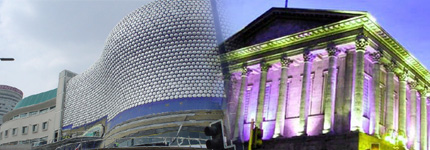|
City Community
Accommodation
Bars Pubs
Clubs
Escorts
Hair & Beauty
Restaurants
Saunas
Services
Shops
 Download Maps Download Maps
 Download Movies Download Movies


|


[english] [español] [français] [deutsch] [italiano]
Birmingham (England),...
...city, seat of the metropolitan county of West Midlands, central England. In 1974 the former municipal borough of Sutton Coldfield was incorporated into the city. A major industrial center, Birmingham is the second largest city in Britain. It is the hub of the British metal goods industry and is served by a network of railroads and highways. Among the principal metal products manufactured are motor-vehicle parts, machine tools, brassware, household utensils, sporting guns, and jewelry. Other important manufactures include electrical equipment, glass, rubber products, and chemicals. The city is located in an important coal-mining region.
Birmingham is the seat of the University of Birmingham (1900), the University of Aston in Birmingham (1895), the University of Central England in Birmingham (1992, formerly a polytechnic college), and several technical schools. Cultural facilities include the large Birmingham Museums and Art Gallery (1867), the Museum of Science and Industry, the City of Birmingham Symphony Orchestra, and the Birmingham Repertory Theatre (1913). The city's Municipal Bank (opened 1916) is the only one of its kind in Britain. Birmingham churches include Saint Philip's Cathedral (1715), Saint Martin's Parish Church in the Bull Ring (13th century), and the Roman Catholic Saint Chad's Cathedral (1841). Other notable buildings are the neoclassical Town Hall (1834), the Renaissance-style Council House (1881), and the modern Bull Ring Shopping Centre.
In 1166 the town of Birmingham was granted a market charter. By the 16th century, it had become a thriving manufacturing center specializing in metal goods. At the time of the English Revolution in the 1640s, Birmingham produced some 16,000 sword blades for the Parliamentary forces, as a result of which the town was besieged and taken by the Royalists. Because of its manufacturing capacity, Birmingham assumed a position of great importance in the late 18th century, during the Industrial Revolution. Active in the town at that time were a number of influential inventors and scientists, including the inventor of the steam engine, James Watt, and the chemist Joseph Priestley. In 1838 railroad lines were constructed from Birmingham to London and Liverpool. During the late 19th century, the city became known for its outstanding municipal improvement programs, such as those devoted to the establishment of public utilities and the clearing of slums. Heavily bombed during World War II (1939-1945), the city has undergone extensive rebuilding.
Population (2001 estimate) 976,400.
"Birmingham (England)," Microsoft® Encarta® Online Encyclopedia 2004
http://encarta.msn.com © 1997-2004 Microsoft Corporation. All Rights Reserved.
|
